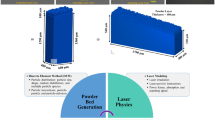Abstract
Precision glass molding (PGM) has been developed and improved to produce various functional lenses in the optical industry. Tungsten carbide (WC) molds have received increasing attention due to the low thermal expansion coefficient and long service time but the molds are difficult to machine using micro-cutting or micro-grinding methods. Electrical discharge machining (EDM) milling is a promising method for the fabrication of WC molds used for microlens arrays but the significant electrode wear results in low machining accuracy. In this paper, a new method is proposed to address the electrode wear by utilizing in situ electrode trimming during EDM milling; the objective is to improve the accuracy of the WC mold used for microlens array fabrication. The feasibility of the proposed in situ electrode trimming method is verified by comparing the surface roughness of the pits on the mold surface fabricated by EDM milling with and without electrode trimming. In addition, the structure of the copper–tungsten electrode is redesigned to improve the electrode stiffness during in situ trimming. Furthermore, an in situ trimming setup is developed and the trimming process of the electrode is optimized.












Similar content being viewed by others
References
Zhou TF, Yan JW, Masuda J, Kuriyagawa T (2009) Investigation on the viscoelasticity of optical glass in ultraprecision lens molding process. J Mater Process Technol 209(9):4484–4489
Ding ZL, Deng JX, Zen XH, Wu JP, Zou YS (2008) Thermal erosion n of WC-based cemented carbide nozzles by coal water slurry. P I Mech Eng B-J Eng 26:334–339
Jahan MP, Rahman M, Wong YS (2011) A review on the conventional and micro-electro discharge machining of tungsten carbide. Int J Mach Tool Manu 51(12):837–858
Kai E, Shigeyuki H, Sho T, Yusuke M (2011) Fabrication and cutting performance of cemented tungsten carbide micro-cutting tools. Precis Eng 35(4):547–553
Chou SH, Wang AC (2014) Investigating and removing the re-sticky debris on tungsten carbide in electrical discharge machining. Int J Adv Manuf Technol 71(5–8):1151–1158
Pei JY, Zhuang XS, Zhang LN, Zhu YT, Liu YB (2017) An improved fix-length compensation method for electrical discharge milling using tubular tools. Int J Mach Tool Manu: S0890695517301372
Dimov S, Pham DT, Ivanov A, Popov K (2003) Tool-path generation system for micro-electro discharge machining milling. P I Mech Eng B-J Eng 217(B):1633–1637
Lin YC, Yan BH, Huang FY (2001) Surface improvement using a combination of electrical discharge machining with ball burnish machining based on the Taguchi method. Int J Adv Manuf Technol 18(9):673–682
Lim HS, Wong YS, Rahman M, Edwin Lee MK (2003) A study on the machining of high-aspect ratio micro-structures using micro-edm. J Mater Process Technol 140(1–3):318–325
Masuzawa T, Tönshoff HK (1997) Three-dimensional micromachining by machine tools. Cirp Ann-Manuf Techn 46(2):621–628
Bissacco G, Valentincic J, Hansen HN, Wiwe BD (2010) Towards the effective tool wear control in micro-edm milling. Int J Adv Manuf Technol 47(1–4):3–9
Jeong YH, Min BK (2007) Geometry prediction of edm-drilled holes and tool electrode shapes of micro-edm process using simulation. Int J Mach Tool Manu 47(12):1817–1826
Zhao YS, Zhang XQ, Liu XB, Yamazaki K (2004) Geometric modeling of the linear motor driven electrical discharge machining (edm) die-sinking process. Int J Mach Tool Manu 44(1):1–9
Bleys P, Kruth JP, Lauwers B (2004) Sensing and compensation of tool wear in milling edm. J Mater Process Technol 149(1–3):139–146
Hinduja S, Kunieda M (2013) Modelling of ecm and edm processes. Cirp Ann-Manuf Techn 62(2):775–797
Yu ZY, Masuzawa T, Fujino M (1998) Micro-EDM for three-dimensional cavities—development of uniform wear method. Cirp Ann-Manuf Techn 47(1):169–172
Pham DT, Dimov SS, Bigot S, Ivanov A, Popov K (2004) Micro-edm—recent developments and research issues. J Mater Process Technol 149(1–3):50–57
Puthumana G, Bissacco G, Hansen HN (2017) Modeling of the effect of tool wear per discharge estimation error on the depth of machined cavities in micro-EDMmilling. Int J Adv Manuf Technol 92(9):3253–3264
Bissacco G, Tristo G, Hansen HN, Valentincic J (2013) Reliability of electrode wear compensation based on material removal per discharge in micro edm milling. Cirp Ann-Manuf Techn 62(1):179–182
Bissacco G, Hansen HN, Tristo G, Valentincic J (2011) Feasibility of wear compensation in micro edm milling based on discharge counting and discharge population characterization. Cirp Ann-Manuf Techn 60(1):231–234
Lim HS, Son SM, Wong YS, Rahman M (2007) Development and evaluation of an on-machine optical measurement device. Int J Mach Tool Manu 47(10):1556–1562
Aligiri E, Yeo SH, Tan PC (2010) A new tool wear compensation method based on real-time estimation of material removal volume in micro-edm. J Mater Process Technol 210(15):2292–2303
Khan MAR, Rahman MM (2017) Surface characteristics of Ti-5Al-2.5Sn in electrical discharge machining using negative polarity of electrode. Int J Adv Manuf Technol 92:1–13
Liu QY, Zhang QH, Zhu G, Wang K, Zhang JH, Dong CJ (2016) Effect of electrode size on the performances of micro-edm. Mater Manuf Process 31(4):6
Author information
Authors and Affiliations
Corresponding author
Additional information
Publisher’s note
Springer Nature remains neutral with regard to jurisdictional claims in published maps and institutional affiliations.
Rights and permissions
About this article
Cite this article
Zhou, T., Ma, F., Ruan, B. et al. Microlens array fabrication on WC mold using EDM milling with in situ electrode trimming. Int J Adv Manuf Technol 103, 3003–3011 (2019). https://doi.org/10.1007/s00170-019-03731-0
Received:
Accepted:
Published:
Issue Date:
DOI: https://doi.org/10.1007/s00170-019-03731-0




